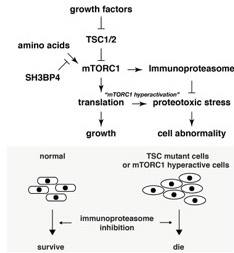Tuberous Sclerosis Complex
Targeting Amino Acid-mTORC1 Signaling for Treatment of TSC
Posted September 17, 2016
Do-Hyung Kim, PhD, University of Minnesota, Twin Cities

Cells have developed mechanisms to respond to the conditions around them, growing when nutrients are plentiful, but surviving when they are not. One protein complex, mammalian target of rapamycin complex 1 (mTORC1), plays a key role in cell growth in response to amino acid availability. While mutations in the tuberous sclerosis complex (TSC) genes can affect mTORC1 signaling in response to growth factors, the role this plays with regard to amino acid availability in the disease is less well understood. Dr. Do-Hyung Kim was awarded a fiscal year 2012 Idea Development Award to study targeting amino acid-mTORC1 signaling in TSC.
Dr. Kim proposed to examine a protein named SH3BP4, which his lab identified as a negative regulator of amino acid-mTORC1 signaling, and its interactions with Rag GTPase and mTORC1. In examining SH3BP4 function in amino acid-mTOR signaling, Dr. Kim and his team found that this protein may be involved in endosomal trafficking. This fed into studies on the endosomal protein UVRAG in the mTORC1 pathway. His team found that mTORC1 binds to and phosphorylates UVRAG, attenuating endosome maturation and lysosomal degradation of growth factor receptors. This suggests that amino acid/SH3BP4/mTORC1 signaling, through UVRAG, can mediate levels of cell surface growth factor receptors. Indeed, Dr. Kim and his laboratory found that TSC1 and TSC2 null mouse cells expressed high levels of several growth factor receptors on the cell surface that are often found overexpressed on tumor cells.
In looking for mediators for amino acid-mTORC1 signaling, Dr. Kim’s group found that mTORC1 promotes immunoproteasome formation in a manner dependent upon amino acids and mTORC1 activity, linking amino-acid-mTORC1 signaling to the production of immunoproteasomes. Immunoproteasomes are upregulated to counter protein stress caused by aberrant proteins that result from reduced fidelity when mTORC1 signaling increases protein synthesis, allowing the cells to survive. They also found that TSC mutant mouse cells had increased immunoproteasome activity. Through these studies, Dr. Kim has uncovered new pathways mediated by mTORC1 signaling that have resulted in novel potential targets for therapy in TSC.

Publications:
Kim Y-M, Jung CH, Seo M, Kim EK, Park J-M, Bae SS, and Kim D-H. 2015. mTORC1 phosphorylates UVRAG to negatively regulate autophagosome and endosome maturation. Molecular Cell 57:207-218. PMID: 25533187; PMCID: PMC4304967
Yun YS, Kim KH, Tschida B, Sachs Z, Noble-Orcutt KE, Moriarity BS, Ai T, Ding R, Williams J, Chen L, Largaespada D, Kim D-H. 2016. mTORC1 coordinates protein synthesis and immunoproteasome formation via PRAS40 to prevent accumulation of protein stress. Molecular Cell 61:625-39. PMID: 26876939
Links:
Abstracts
Public and Technical Abstracts: Targeting Amino Acid-mTORC1 Signaling Limb for TSC Suppression
Last updated Thursday, December 5, 2024














